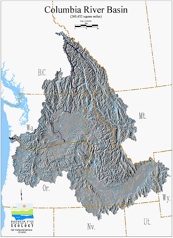Odessa Aquifers:
Crisis in Sustainability
Prepared by Rachael Paschal Osborn
Columbia Institute for Water Policy
last updated November 10, 2006

Odessa Aquifers:
Crisis in Sustainability
Prepared by Rachael Paschal Osborn
Columbia Institute for Water Policy
last updated November 10, 2006
Odessa in a Nutshell
This website explores water resource issues associated with the Odessa Subarea, in central-eastern Washington state. The following pages present resource information about the condition of the groundwater that lies beneath the Odessa and the natural and human factors that have contributed to severe water depletion in the area. Much of the information set forth here has been gleaned from public agency reports and files.
The Solutions pages examine various options for addressing water issues in the Odessa Subarea, ranging from direct buy-outs, importing water from the Columbia River, water conservation transfers, and reversion to dryland cropping.
• The Odessa Subarea is a 2,000-square mile area in the arid interior of the Columbia Plateau. It is farming country interspersed with scablands and some last pockets of undeveloped shrub-steppe habitat. Farming is done in two ways -- either as dryland cropping or irrigated from deep aquifers.
• Water levels in the deep aquifers of the Odessa Subarea have been in decline since the 1960s. The causes for this groundwater depletion include overpumping by irrigators, combined with the use of hundreds (perhaps thousands) of illegally constructed wells that allow groundwater to cascade from upper aquifers to lower aquifers.
• Water supply problems in the Odessa Subarea are driving water policy and water development activities in Washington state. The situation in Odessa is critical to understanding the new dam building programs being promoted by the State of Washington and the U.S. Bureau of Reclamation.
•In September 2006, the U.S. Bureau of Reclamation issued a preliminary study of the Odessa Subarea. The study calls for diverting more water from the Columbia River, and expansion and construction of extensive canals and laterals. The study assumes that water must be supplied to Odessa, but fails to discuss the tremendous environmental and financial (taxpayer) costs associated with the options for water supply.
• Loss of potato production is one of the largest concerns with respect to Odessa water declines. Potatoes are the most valuable crop grown in the Odessa Subarea, however, what little analysis exists overstates the economic impacts (citing worst case economic scenarios that are not expected to occur). There has been no discussion of important agronomic factors, i.e., that potatoes require crop rotation and eventual movement to new ground to avoid pests, disease and eventual declines in yield.
• Moreover, the Department of Ecology projects that there will be little new future demand for crop acreage. The Nov. 2006 Water Supply Inventory, prepared for the Washington State Legislature, notes that “The expected trend in total crop acreage shows a stable pattern with no significant increase or decrease in acreage. . . . In terms of potential water demand, the lack of an increase in acreage and overall stability in crop patterns would suggest that, in aggregate, the demand for irrigation water should remain relatively constant with no significant new demand.”
•In December 2005, the State of Washington issued a preliminary study of 21 potential new dam and reservoir sites adjacent to the Columbia River. In September 2006, the state narrowed the list to four sites. It is Washington’s goal to build dams to provide water to Odessa-area irrigators, along with other irrigators in the Columbia basin. The state has not compared the costs and benefits of new dams, and as noted above, is predicting in other documents that water demand will not increase, but has nonetheless committed more than $200 million to the program.
•Non-sustainable water use is an unfortunate hallmark of irrigated farming on the Columbia Plateau. With average rainfall of 10 inches per year, irrigated farming is only possible by (1) diverting water out of the Columbia River, with significant adverse impacts on endangered salmon species or (2) overpumping groundwater. Irrigated agriculture impacts streams, wetlands and shrub steppe ecosystems within the Columbia Plateau.
•The delivery of irrigation water to Columbia Plateau farms is enormously expensive; the Columbia Basin Project represents one of the largest water subsidies in the United States. Proposals to extend water service to Odessa farms will add to the subsidy and must be carefully balanced against the benefits. To date, no economic analysis of costs and benefits has occurred.
•Dryland cropping developed as a response to the water supply limitations of the Columbia Plateau, and is a successful farming method for hundreds of thousands of acres in the Columbia basin. Neither Washington state nor the U.S. Bureau of Reclamation has analyzed the viability of dry land farming as a solution for the Odessa water supply shortage.
•The Washington Department of Ecology and the U.S. Bureau of Reclamation are spending millions of dollars to study new dams and reservoirs in the Columbia basin, the most heavily dammed watershed on the planet. Even a single dam would cost more than a billion dollars. But these government agencies have yet to analyze whether more environmentally and economically beneficial approaches to promoting agriculture in the Columbia basin are available.
Next: Introduction to the Odessa Aquifers: Crisis in Sustainability

Columbia Institute for Water Policy










Map source: “Ecology Investment Atlas, Columbia Basin Projects, July 1, 2005 - June 30, 2007, $18,626,693” WA Dept of Ecology.
Click here to enlarge